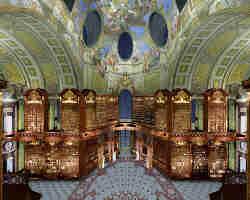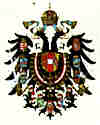In its early years, the land that became Austria was invaded by a succession of tribes and armies using the Danube Valley as a conduit - the Celts, Romans, Vandals, Visigoths, Huns, Avars, Slavs. Therefore the Babenberger Dynasty was sent to established a territory in the Danube Valley known as the Ostarrichi in 803, to prevent these invasions; and the area became Christianised and predominantly Germanic.
The Babenbergers, who moved their residence to Vienna, controlled Austria for nearly 300 years until Duke Friedrich died childless in 1246 leaving his lands once again open to warring tribes.
By 1278 the Habsburgs had gained control and this mighty dynasty managed to rule Austria right up until WW I. Although the Habsburgs were not averse to using a bit of muscle, they preferred less barbaric ways of extending their territory and so Austria gradually expanded thanks to judicious real estate purchases and many politically-motivated marriages.
New territories were acquired, which resulted in the Habsburgs, now also the Holy Roman Emperors, ruling much of central Europe including Hungary and Bohemia and Croatia, parts of Poland, Romania, Bulgaria, Italy, Ukraine, as well as the Netherlands and Spain and its vast overseas possessions. (The Empire was divided into a Spanish and Austrian half in 1556.)
 In 1571, when the emperor granted religious freedom, the vast majority of Austrians turned to Protestantism. In 1576, the new emperor, Rudolf II, embraced the Counter-Reformation and much of the country reverted, with a little coercion, to Catholicism. The attempt to impose Catholicism on Protestant areas of Europe led to the Thirty Years' War, which started in 1618 and devastated much of Central Europe. Peace was finally achieved in 1648 with the Treaty of Westphalia. For much of the rest of the century, Austria was preoccupied with halting the advance of the Turks into Europe.
In 1571, when the emperor granted religious freedom, the vast majority of Austrians turned to Protestantism. In 1576, the new emperor, Rudolf II, embraced the Counter-Reformation and much of the country reverted, with a little coercion, to Catholicism. The attempt to impose Catholicism on Protestant areas of Europe led to the Thirty Years' War, which started in 1618 and devastated much of Central Europe. Peace was finally achieved in 1648 with the Treaty of Westphalia. For much of the rest of the century, Austria was preoccupied with halting the advance of the Turks into Europe.
Vienna nearly capitulated to a Turkish siege in 1683 but was rescued by a Christian force of German and Polish soldiers. Austrian forces under General Prince Eugene subsequently swept the Turks to the south-eastern edge of Europe. The removal of the Turkish threat saw a frenzy of Baroque building in many cities, and under the musical emperor Leopold I, Vienna became a magnet for musicians and composers. In fact many of the Habsburgs were themselves gifted musicians and would, history allowing, have made a funky quartet consisting of Leopold I (composer), Charles VI (violin), Maria Theresa (double bass) and Joseph II (harpsichord and cello)
 The Gothic style was popular between the 14th and 16th centuries, as evidenced by the number of imposing buildings with flying buttresses, pointed arches, ribbed ceiling vaults and pigeon toes.
St Stephen's Cathedral in Vienna is considered to be Austria's Gothic masterpiece. The next major stylistic influence was Baroque. Learning from the Italian model, Fischer von Erlach developed a national style called Austrian Baroque, typified in the National Library and the Church of St Charles in Vienna. Empress Maria Theresa had a fling with Rococo.
The Gothic style was popular between the 14th and 16th centuries, as evidenced by the number of imposing buildings with flying buttresses, pointed arches, ribbed ceiling vaults and pigeon toes.
St Stephen's Cathedral in Vienna is considered to be Austria's Gothic masterpiece. The next major stylistic influence was Baroque. Learning from the Italian model, Fischer von Erlach developed a national style called Austrian Baroque, typified in the National Library and the Church of St Charles in Vienna. Empress Maria Theresa had a fling with Rococo.
( Foto left: St.Charles Church; Foto right up: National Library
In 1740, Maria Theresa ascended the throne and ruled for 40 years. This period is generally acknowledged as the era in which Austria developed as a modern state. During her reign, control was centralised, a civil service was established, the army and economy were reformed and a public education system was introduced. However, progress was halted when Napoleon defeated Austria at Austerlitz in 1805. European conflict dragged on until the settlement at the Congress of Vienna in 1814-15. Austria was left with control of the German Confederation but suffered upheaval during the 1848 revolutions and eventual defeat in the 1866 Austro-Prussian War.
 This led to the formation of the dual monarchy of Austria-Hungary in 1867 under emperor Franz Josef and exclusion from the new German empire unified by Bismarck. A period of prosperity followed but Austria's expansionist tendencies in the Balkans and its annexation of Bosnia-Herzegovina in 1908 led to the assassination of the emperor's nephew in Sarajevo in June 1914 by serbian separatists. A month later, Austria-Hungary declared war on Serbia, the Russians came to the Serbians aid and the slaughter of WW I began in earnest.
This led to the formation of the dual monarchy of Austria-Hungary in 1867 under emperor Franz Josef and exclusion from the new German empire unified by Bismarck. A period of prosperity followed but Austria's expansionist tendencies in the Balkans and its annexation of Bosnia-Herzegovina in 1908 led to the assassination of the emperor's nephew in Sarajevo in June 1914 by serbian separatists. A month later, Austria-Hungary declared war on Serbia, the Russians came to the Serbians aid and the slaughter of WW I began in earnest.
( Map: Austrian Empire before World War I and the "rest" of today. )
At the conclusion of the war, the shrunken Republic of Austria was created and was forced to recognise the independent states of Czechoslovakia, Poland, Hungary and Yugoslavia which, along with Romania and Bulgaria, had previously been under control of the Habsburgs. The new republic suffered economic strife which led to an upsurge in Nazi-style politics. Austria's embrace of fascism meant that German troops met little opposition when they invaded in 1938 and incorporated Austria into the Third Reich. A national referendum in Austria that year supported the annexation. For its troubles, Austria was bombed heavily in WW II and by 1945 it had been restored to its 1937 frontiers by the victorious Allies. It was divided into four zones by occupying American, British, French and Russian troops who remained entrenched for a decade before withdrawing and allowing Austria to proclaim its neutrality.
The republic of Austria was once the center of an empire that stretched across Central Europe and was home to 70 million citizens. Read a 1914 Encyclopedia Britannica entry on
Austria-Hungary to understand the empire at the peak of its power. Then view an archive of
historical documents of the Austro-Hungarian Empire.





 In 1571, when the emperor granted religious freedom, the vast majority of Austrians turned to Protestantism. In 1576, the new emperor, Rudolf II, embraced the Counter-Reformation and much of the country reverted, with a little coercion, to Catholicism. The attempt to impose Catholicism on Protestant areas of Europe led to the Thirty Years' War, which started in 1618 and devastated much of Central Europe. Peace was finally achieved in 1648 with the Treaty of Westphalia. For much of the rest of the century, Austria was preoccupied with halting the advance of the Turks into Europe.
In 1571, when the emperor granted religious freedom, the vast majority of Austrians turned to Protestantism. In 1576, the new emperor, Rudolf II, embraced the Counter-Reformation and much of the country reverted, with a little coercion, to Catholicism. The attempt to impose Catholicism on Protestant areas of Europe led to the Thirty Years' War, which started in 1618 and devastated much of Central Europe. Peace was finally achieved in 1648 with the Treaty of Westphalia. For much of the rest of the century, Austria was preoccupied with halting the advance of the Turks into Europe. The Gothic style was popular between the 14th and 16th centuries, as evidenced by the number of imposing buildings with flying buttresses, pointed arches, ribbed ceiling vaults and pigeon toes.
St Stephen's Cathedral in Vienna is considered to be Austria's Gothic masterpiece. The next major stylistic influence was Baroque. Learning from the Italian model, Fischer von Erlach developed a national style called Austrian Baroque, typified in the National Library and the Church of St Charles in Vienna. Empress Maria Theresa had a fling with Rococo.
The Gothic style was popular between the 14th and 16th centuries, as evidenced by the number of imposing buildings with flying buttresses, pointed arches, ribbed ceiling vaults and pigeon toes.
St Stephen's Cathedral in Vienna is considered to be Austria's Gothic masterpiece. The next major stylistic influence was Baroque. Learning from the Italian model, Fischer von Erlach developed a national style called Austrian Baroque, typified in the National Library and the Church of St Charles in Vienna. Empress Maria Theresa had a fling with Rococo. This led to the formation of the dual monarchy of Austria-Hungary in 1867 under emperor Franz Josef and exclusion from the new German empire unified by Bismarck. A period of prosperity followed but Austria's expansionist tendencies in the Balkans and its annexation of Bosnia-Herzegovina in 1908 led to the assassination of the emperor's nephew in Sarajevo in June 1914 by serbian separatists. A month later, Austria-Hungary declared war on Serbia, the Russians came to the Serbians aid and the slaughter of WW I began in earnest.
This led to the formation of the dual monarchy of Austria-Hungary in 1867 under emperor Franz Josef and exclusion from the new German empire unified by Bismarck. A period of prosperity followed but Austria's expansionist tendencies in the Balkans and its annexation of Bosnia-Herzegovina in 1908 led to the assassination of the emperor's nephew in Sarajevo in June 1914 by serbian separatists. A month later, Austria-Hungary declared war on Serbia, the Russians came to the Serbians aid and the slaughter of WW I began in earnest.